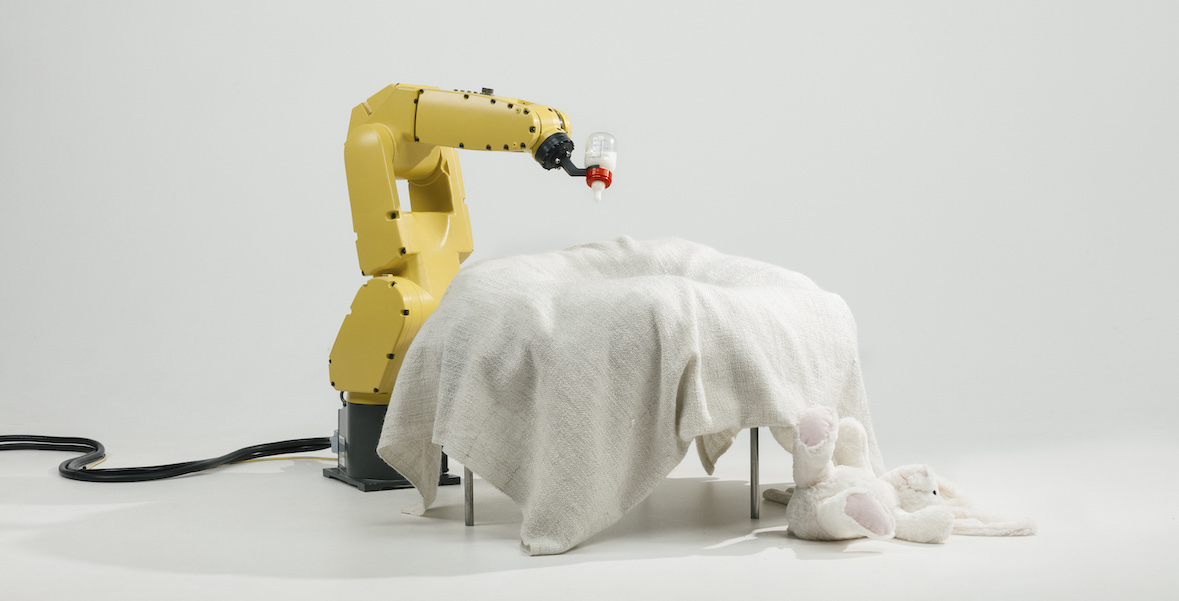Editor’s Note: The Pamela and Ajay Raju Foundation’s annual high school essay writing contest was inspired this year by the Philadelphia Museum of Art’s latest exhibit, Designs for Different Futures, which features ways to address the values, needs and desires of society in a changing world. The winner, Mary Cipperman, won a $5,000 scholarship, another $5,000 to support an internship with the PMA’s curatorial team and naming rights on a piece of artwork purchased by the Raju Foundation (which also supports The Citizen) and donated to the museum. Mary chose the gift pictured above, called “Raising Robotic Natives.”
What would happen if humans could sense ultraviolet light? What if we could run twice as fast or see twice as far? What if we never aged? Technology has shaped human beings since Mesopotamian times; however, in the past two decades, we have begun to elevate the human condition beyond our current sensory and cognitive functionalities. This movement has a name: Max More, founder of the Alcor Life Extension Foundation and leading futurist, first defined “transhumanism” as “a class of philosophies that seek the continuation…of intelligent life beyond its current human form and human limitations.” He described not one invention but rather a framework for applying and developing transformative technologies, such as genetic engineering, cybernetics, brain emulation, and artificial intelligence. While transhumanism could threaten our identity and welfare, it potentially affords improved productivity and survival for the future of humanity.

The idea of enhancing human beings is not new, nor is its bioethical concerns. Steroid hormones as well as neurological stimulants such as caffeine alter the human body and heighten performance. Likewise, amphetamine gained pharmacological praise as early as the 1920s. Such neurological enhancers beg the question of misuse. Doctors and ethicists alike question whether we should apply drugs that could improve mood or lessen fatigue to individuals with perfectly normal hormone levels. After all, such usage would leave behind individuals with disorders and elevate others beyond normal human abilities. Steroid hormones, for example, allow athletes to enhance their workouts and performance, but we consider this practice unethical in certain formal competitions. Still, if dietary supplements have similar effects on the human body, how do we draw a distinction between these two practices?
![]() Unfortunately, these concerns bear even greater consequences as the magnitude of our technological development grows. Consider the difference between erythropoietin-stimulating agents and genetic engineering. Both can increase hormone levels, but the latter can alter the allelic frequencies of subsequent generations. This distinction—of inheritability, lack of precedent, and magnitude of impact—marks a new subset of enhancing technologies; those that alter human nature.
Unfortunately, these concerns bear even greater consequences as the magnitude of our technological development grows. Consider the difference between erythropoietin-stimulating agents and genetic engineering. Both can increase hormone levels, but the latter can alter the allelic frequencies of subsequent generations. This distinction—of inheritability, lack of precedent, and magnitude of impact—marks a new subset of enhancing technologies; those that alter human nature.
In light of these radical developments, bioethicists have begun to question how transhuman technologies could affect the boundaries and wellbeing of humanity. Permanent alterations, such as gene editing, could facilitate exploitation. Governments or higher institutions could use these technologies to increase submissiveness or institute eugenic programs. Certain individuals could choose not to alter their genes. These circumstances would increase polarizations of power and undermine equality and freedom.
As we look forward, we can postulate that engineers and scientists will design not only our future, but ourselves.
Genetic engineering raises another, deeper, concern with transhumanism as well: whether we should consider human nature to be malleable and changeable, as transhumanists suggest. The 1997 Universal Declaration on the Human Genome and Human Rights suggests that the genome, as “the heritage of humanity,” belongs not to individuals, but to our species collectively. This might indicate that genetic engineering of any kind infringes on human rights. Furthermore, cognitive technologies like brain emulation have the potential to separate consciousness from physicality. This, and other uses for AI, demonstrate that intelligent life can exist beyond human beings—whether in the form of robots or enhanced posthumans. This change is occurring now: four years ago, the Open Worm Project at Oxford modeled over three-hundred neurons of a C. elegans with computer software. The scientists then uploaded the worm’s brain onto a robot that emulated the movement of the original organism. If these, and other intelligences, were to gain consciousness, we would need to determine whether these constitute living beings. Further, we must be willing and able to control them.
![]() Despite these concerns, transhumanism has enormous potential. Cochlear ear implants and bionic eyes, for example, have already enhanced human capabilities for decades. Altering the human body via cyborgization may not be inherently wrong; otherwise hearing aids would be unethical. Transhumanists merely intend to extend the magnitude of these alterations in order to overcome all death, disability, and disease. We could potentially decrease decisional fatigue and improve memory. Others even argue that pursuing these advances is not just ethical, but morally obligatory. Psilocybin, for example, has the potential for moral enhancement. If we could make human beings more empathetic, our viewpoints towards climate change and nuclear warfare could save us as a species. Thus, many bioethicists do not object to the concept of enhancement itself, but rather to its unintended consequences or safety concerns.
Despite these concerns, transhumanism has enormous potential. Cochlear ear implants and bionic eyes, for example, have already enhanced human capabilities for decades. Altering the human body via cyborgization may not be inherently wrong; otherwise hearing aids would be unethical. Transhumanists merely intend to extend the magnitude of these alterations in order to overcome all death, disability, and disease. We could potentially decrease decisional fatigue and improve memory. Others even argue that pursuing these advances is not just ethical, but morally obligatory. Psilocybin, for example, has the potential for moral enhancement. If we could make human beings more empathetic, our viewpoints towards climate change and nuclear warfare could save us as a species. Thus, many bioethicists do not object to the concept of enhancement itself, but rather to its unintended consequences or safety concerns.
While transhumanism raises the concerns of exploitation and safety, it has transformed lives already and promises even greater advances for the future. Transhumanism describes not one invention or development but rather a radical alteration of the interaction between humans and their environments. To embrace it too readily would be to accept a complete and potentially dangerous redefinition of both technology and humanity. Yet, to reject it would be to relinquish a plethora of multidisciplinary opportunities. The future certainly promises a new cultural, social, and political framework for defining the very essence of humanity. It holds machines that create art and recognize faces, as well as human beings designed with metallic limbs and silicon brains. As we look forward, we can postulate that engineers and scientists will design not only our future, but ourselves.
Header photo: Raising Robotic Natives © Stephan Bogner, Philipp Schmitt, Jonas Voigt. 2016.





